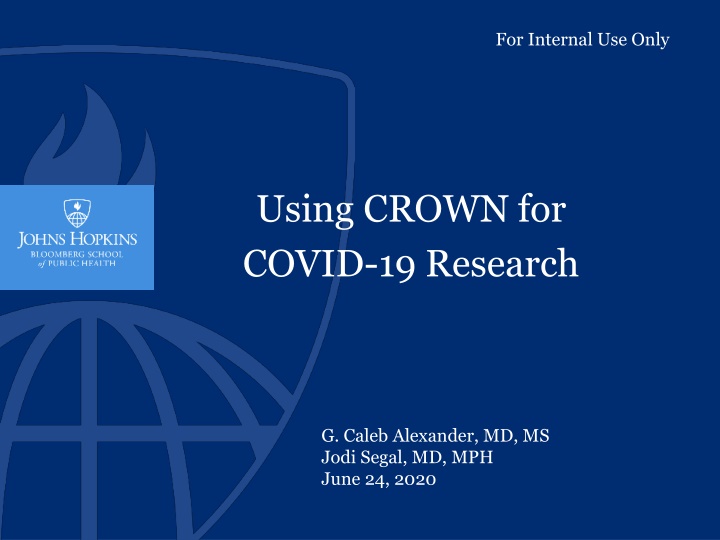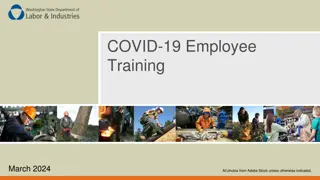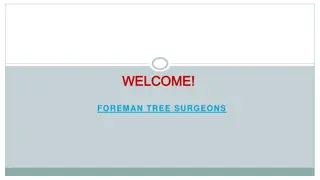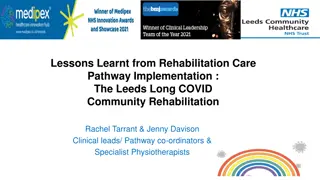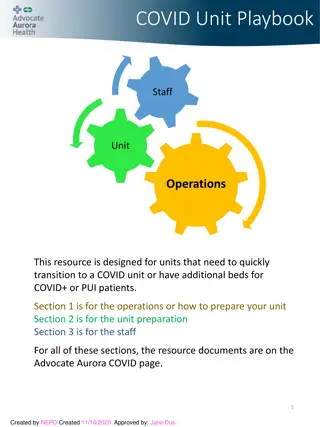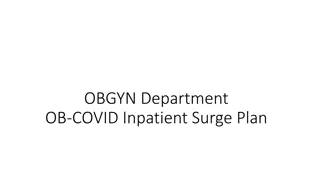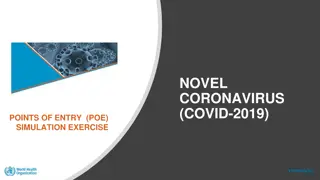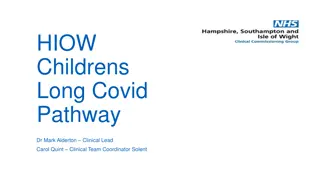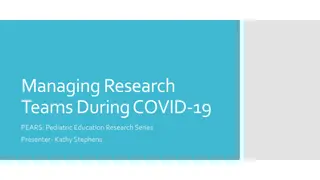Using CROWN for COVID-19 Research
Pharmacoepidemiologists emphasize the need for fit-for-purpose data in COVID-19 research. They discuss the strengths and weaknesses of electronic health information, challenges with longitudinal data, and sources of EMR like JH-CROWN and PCORNet. The JH-CROWN Registry criteria and types of research questions are highlighted in this informative content.
Download Presentation

Please find below an Image/Link to download the presentation.
The content on the website is provided AS IS for your information and personal use only. It may not be sold, licensed, or shared on other websites without obtaining consent from the author.If you encounter any issues during the download, it is possible that the publisher has removed the file from their server.
You are allowed to download the files provided on this website for personal or commercial use, subject to the condition that they are used lawfully. All files are the property of their respective owners.
The content on the website is provided AS IS for your information and personal use only. It may not be sold, licensed, or shared on other websites without obtaining consent from the author.
E N D
Presentation Transcript
For Internal Use Only Using CROWN for COVID-19 Research G. Caleb Alexander, MD, MS Jodi Segal, MD, MPH June 24, 2020
Just to level set . . . We are pharmacoepidemiologists (not informaticians) Data must be fit for purpose There is no perfect dataset (or study) Electronic health information has strengths and weaknesses
Just to level set . . . We are pharmacoepidemiologists (not informaticians) Data must be fit for purpose There is no perfect dataset (or study) Electronic health information has strengths and weaknesses + - Longitudinal data about an individual Much of the information is in free text Results from laboratory testing, other diagnostics Much missing data (e.g. behaviors, family history, diet) In-patient administered medications May not know if prescriptions were filled A problem list A single health system s services Ordered medications Typically no cost information
There are many sources of EMR Single center (e.g., JH-CROWN) Multi-center (federated and non-federated) PCORNet: National Patient-Centered Clinical Research Network (9 large Clinical Research Networks, 2 Health Plan Research Networks, and a Coordinating Center) PATH: JHU, Geisinger, Penn State, Temple, University of Pittsburgh, Ohio State, University of Michigan N3C: National COVID Cohort Collaborative: Partnership among NCATS-supported CTSA hubs and National Center for Data to Health (CD2H)
JH-CROWN [Disease] Registry COVID-19 cohort Having a completed laboratory test for COVID-19 (whether positive or negative) or Having an ICD-10 diagnosis of COVID-19 (either recorded at the time of the encounter, entered on the problem list, entered as medical history, or appearing as a billing diagnosis) or Flagged as a patient under investigation for suspected or confirmed COVID-19 infection (Infection flag) https://ictr.johnshopkins.edu/coronavirus/jh-crown/
Types of Research Questions Natural history of COVID-19 Predictors of disease severity Utilization, safety and/or effectiveness of non-pharmacologic interventions (e.g., proning, mode of ventilatory support) Utilization, safety and/or effectiveness of medications Some important questions can t be answered with CROWN (yet) since it has neither a comparator group or denominator Second-order effects (e.g., broader health system effects) Rates of infections, comparative outcomes among those with COVID-19 vs. other diseases
Software https://www.goodcore.co.uk/blog/types-of-software/
Examples of Specific Data Elements Comorbidities Pre-made table on Elixhauser s 29 comorbidities - easy to characterize patient s comorbidity burden Medications medication ordered vs. administered know the difference Lab values - look for different units, missing values, outliers etc. Multiple measurements know which one you need Natural language processing /chart review Effort underway to extract relevant information for research
An Example What is the association between dexamethasone receipt and severity of COVID-19 infection? Cohort Derivation: All individuals? Adults only? Confirmed COVID+ only? Only new admissions? Exposure: Dexamethasone (All or none? Dose response? Other steroids? ITT or as-treated?) Measures. (1) Ventilation; (2) length of stay; (3) in-hospital mortality Covariates. Which ones? Why? At date of hospitalization . . . Sociodemographics (age, sex, zip code, self-reported race and ethnicity) Clinical features (drug abuse, current alcohol use, smoking history, body mass index, whether a person was admitted from a nursing home) Days since positive SARS-CoV-2 PCR test Vital signs within 24 hours of admission (temp, pulse, resp, SaO2/FiO2 ratio) Select laboratory measures 2 days of admission Select pharmacologic therapies current on admission
An Example (cont) What is the association between dexamethasone receipt and severity of COVID-19 infection? Cohort Derivation: All individuals? Adults only? Confirmed COVID+ only? Only new admissions? Exposure: Dexamethasone (All or none? Dose response? Other steroids? ITT or as-treated?) Measures. (1) Ventilation; (2) length of stay; (3) in-hospital mortality Covariates. Which ones? Why? At date of hospitalization . . . Modeling. Propensity score-derived inverse probability weights to balance groups at the date of hospitalization, stabilization of weights, analyses of standardized mean differences after weighting, further adjustment. Cox proportional hazards (ventilation, mortality) and multivariable linear regression (length of stay)
What will make things difficult? 1.There are lots of people working in almost every COVID space (but these are big questions, and there are always ways to innovate) 2. You will not have as much info as you would like on the people you are observing (so design questions accordingly, consider looking at subpopulations and don t let perfect be the enemy of the good) 3. There is a ton going on , with strong secular changes, so tough to isolate exposures (so design analytic plans to take this into account, limit exposure windows, use historical controls with caution) 4.Despite speed and efficiency of CADRE, IRB and CROWN team, things still take time (so develop parallel workstreams, figure out what you can do during downtime to advance your science) 5. It is hard to publish single center studies, especially observational ones on COVID (so ask important questions, have realistic expectations about placement/impact, consider scale-up on multisite EMR platforms)
Build on collective experience https://www.collectiveconfidence.com/about
External Resources FDA Guidance: Best Practices for Pharmacoepidemiology Using Electronic Medical Records https://www.fda.gov/files/drugs/published/Best-Practices-for-Conducting-and- Reporting-Pharmacoepidemiologic-Safety-Studies-Using-Electronic-Healthcare-Data- Sets.pdf Free (Archived) Webinar: Addressing Missing Data in Electronic Medical Records https://webed.pharmacoepi.org/products/addressing-missing-data-in-comparative- effectiveness-research-based-on-electronic-health-records Guidelines for Good Pharmacoepidemiologic Practice https://www.pharmacoepi.org/resources/policies/guidelines-08027/
Internal Resources Pm.jh.edu Can only be accessed through SAFE Desktop https://ictr.johnshopkins.edu/coronavirus/jh-crown/ COVID-19 PRECISION MEDICINE ANALYTICS PLATFORM (PMAP) REGISTRY (JH-CROWN) JH-CROWN team Quick, super helpful!
A note of thanks Hemal Mehta, PhD, Assistant Professor of Epidemiology Kayte Andersen, PhD candidate, Epidemiology Natasha Palamuttam, Research Assistant CAUDRE Committee and CROWN Team, including: Christopher Chute Daniel Ford Brian Garibaldi Jacky Jennings Stuart Ray Crystal Williams Bonnie Woods
WHAT IS PUBLIC HEALTH? Protecting Health Saving Lives Millions at a Time
